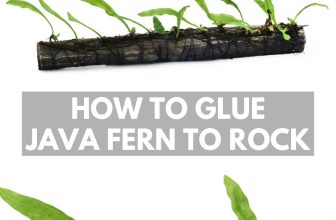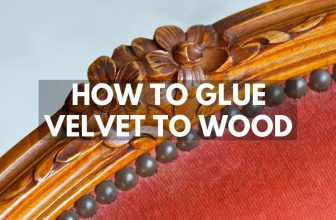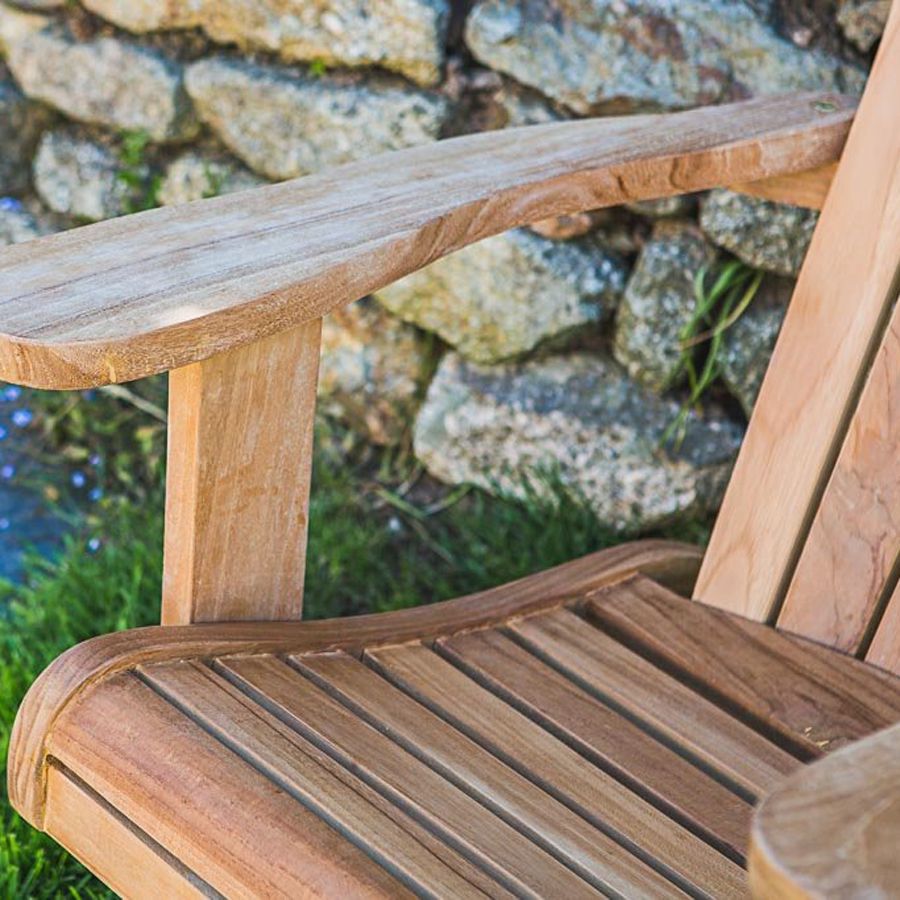
What is the best glue for teak wood?
When trying to glue teak wood, it isn’t always clear which wood glues will work and which could potentially damage your teak. The best glue for teak and other oily woods is epoxy resin. In this guide, we share the most reliable types of epoxy to use on teak.
There really is no better alternative and so in this article, we will specifically look at which is the best epoxy to use on teak. This will include a guide on how to prepare the surfaces, apply the adhesive, and how to achieve a strong bond.
As a rough guide for gluing teak wood, you should pay special attention to surface preparation as the oils from the wood can weaken the adhesive bond. Acetone is used to degrease the surface which is crucial for the glue to stick. We go into details on how to prepare teak for gluing further down the page.
Best Teak Wood Glue Reviews
J-B Weld WoodWeld Epoxy Syringe
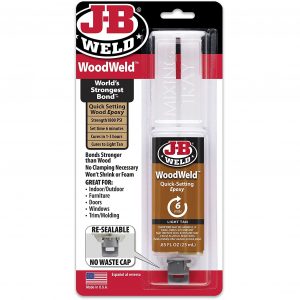

For small teak wood repairs or projects, we recommend the J-B Weld WoodWeld Epoxy Syringe. It bonds to all types of wood very well and shows no negative effects on antique teak wood. Ideal for teak furniture repairs, this glue will create a bond that is stronger than the wood itself.
WoodWeld epoxy dries in a tan color which makes glue joints and repairs more discreet so as to not detract from the character of your wood. It has a tensile strength of 1800 PSI which is enough to hold together large pieces of wood with just a small amount of epoxy.
The simple design allows you to dispense equal parts of epoxy and hardener with one quick squeeze. Complete with mixing tray and stirrer, you have everything you need to glue teak. There is a clever resealable cap on the end which means you don’t have to use all your glue in one go.
Unlike many other epoxy types of glue you can use on teak, J-B Weld WoodWeld has a very short set and cure time. Within 6 minutes the glue will be set in place and cured within 3 hours which is very impressive for a two-part epoxy. We have used this on teak wood with great success and the joints have held for many years.
WEST SYSTEM G/Flex Epoxy
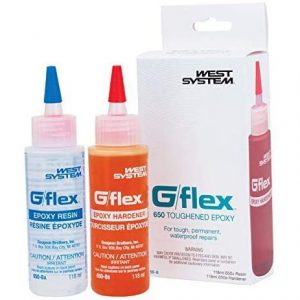

WEST SYSTEM G/Flex Epoxy is the best glue for teak wood. It is incredibly safe to use on valuable teak furniture and is a trusted adhesive for teak boats. It is designed for structural joints that will absorb shock and expansion without breaking so you can rest assured it is reliably strong glue.
Notorious for bonding to difficult types of wood with oily surfaces, G/Flex Epoxy is well suited to old teak and antique wood. You still need to clean the surface with acetone before you use it but will find it sticks very well without much effort.
Mixing the two-part epoxy at a 1:1 ratio gives you roughly 45 minutes of working time before it starts to set. It takes under 10 hours for the glue to fully set and achieve a tensile strength of 3340 psi.
If you need glue for outdoor furniture made of teak then WEST SYSTEM G/Flex Epoxy is the first product I would recommend to anyone. It bonds incredibly well and creates an unbreakable joint that will stand the test of time out in the elements.
Titebond III Ultimate Wood Glue
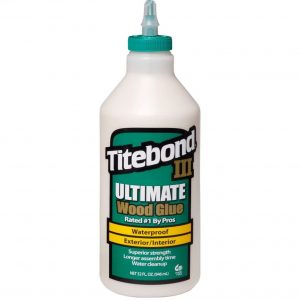

Titebond III Ultimate Wood Glue is an Advanced Proprietary Polymer that claims to be the world’s first 1 part water clean-up waterproof wood glue. You might wonder how a waterproof glue can stay waterproof if it can be cleaned with water. The answer is that it will only clean with water before it sets and then it is permanent.
Being one of the most popular wood glues used by professionals means that there are plenty of testers out there writing reviews. Most people using Titebond III on teak wood report that it works like a charm and is the only type of glue they use on teak. It is very important to use acetone or a similar solvent to thoroughly clean the wood prior to application.
It has a high tensile strength of 4000 PSI which is enough for some weight-bearing joints. Designed for exterior and interior joints, once cured it is 100% waterproof and creates a very strong adhesive bond to teak. The formula is non-toxic, FDA approved, and solvent-free which makes it suitable for indoor use.
We would reach for Titebond III Ultimate Wood Glue for large teak wood projects or on joints that are less visible. It is cheaper than other wood adhesives and can be bought in larger quantities than typical epoxies. Glue Lab’s initial results after using this glue are very good.
Aerodux Resorcinol Resin Kit
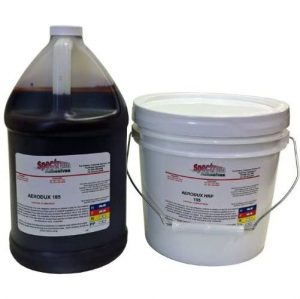

Aerodux Resorcinol Resin is a two-part adhesive well known to woodworkers and boat builders of previous generations. It has for the most part been replaced by advanced epoxies and other specialist wood glues but in our eyes, it remains one of the best glues for teak wood.
It will hold strong in long-term water immersion (including saltwater) and has a high resistance to UV light which is why it is so well trusted in the construction of boats and aircraft. While it is a very strong adhesive for these purposes it does not expand and so is not suitable for filling gaps. It is one of the best teak wood glues for close contact where both mating surfaces fit together very tightly.
A mix ratio of 1:5 is typical with Aerodux Resorcinol (5 parts liquid phenol-resorcinol resin adhesive to 1 part powder hardener). It will be fully cured in around 8 hours and has around a 1400 psi tensile strength rating. As with the other glues we reviewed in this guide, the bond this creates will be stronger than the wood itself.
Some people swear that resorcinol adheres to teak better than any other glue out there while others feel that epoxy resins are far more versatile. One thing is for sure though, you should always prepare teak with acetone and sandpaper before gluing.
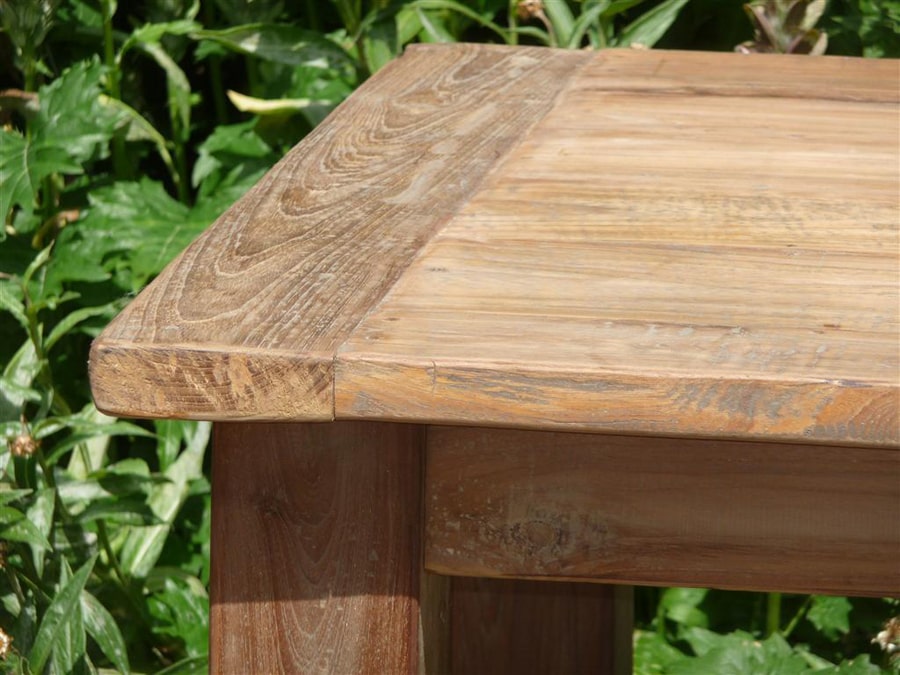
Why is epoxy the best glue for teak?
Because of its oily nature, it can be hard to find glue that works on teak wood. Having spoken to experts in the boat-making industry I can assure you that Epoxy is still the best adhesive for teak. Here is a list of benefits to using epoxy on teak wood:
- Can be used on interior and exterior joints (indoors and outdoors)
- Completely waterproof
- Temperature range of –250°C to 175°C (-418 to 347°F)
- High tensile strength of 3,000 – 8,000 psi
- Will bond to most other surfaces
- Has been tested to work on teak
How to prepare teak wood before gluing?
One of the most important steps to take when gluing teak wood is to remove the natural oils from the surface before starting. Use acetone or denatured alcohol to clean the surface of the teak and get rid of any oils and previous adhesive residues. This is very important but don’t use too much otherwise it might be absorbed into the wood.
Once you have cleaned the teak surface you need to let the solvent fully evaporate before applying any glue. This usually takes a couple of minutes and should be done in a well-ventilated space. During this time you can mix your two-part epoxy or prepare the application tools if using a premix.
Once the solvent has evaporated and the surface is clean you should wipe away any loose debris and prepare to apply the epoxy.
How to glue teak with epoxy
The glue should be applied to the teak minutes after preparing the wood as advised in the previous step. Make sure your two-part epoxy is fully blended together and mixed to the right ratios. Read the label to distinguish how long you have got to apply the glue and ensure you have enough time to use all the epoxy that you mix.
If you are using a syringe applicator to dispense the glue then you can go directly onto the wood in an even pattern. If you are using liquid epoxy and are mixing in a container then you will need a brush. Foam brushes achieve a more uniform coverage than bristle brushes for applying epoxy to teak wood.
Apply a thick layer of glue to the center of the joint you plan to make and then work your way towards the edges making sure there is enough to spread over the entire surface. If you are using a foam brush then you can move the glue around like you would if you were painting.
Once the surface or surfaces have been covered in an abundance of glue it is time to get things into position. Take this slowly as it is better to get it right the first time than to have to try and reposition it. Once you are happy with how the two pieces are joined you can apply a medium-firm pressure to expel any excess glue.
Quickly wipe away the glue as it squeezes out of the gaps so that it doesn’t stain your nice teak wood. Use a clean cloth and if need be, a small amount of solvent but be sure not to get this on the actual joint.
Once you are happy with the positioning and how much pressure is required you need to let the glue set and cure. With teak more than any other wood, it is important not to apply too much pressure to the joint. If you press too hard you reduce the amount of glue between the gap and because epoxy expands slightly as it setsm, you risk damaging the wood.
Adjustable clamps are ideal for the purpose of applying pressure and keeping things in a position which makes them a very useful tool when using epoxy on teak wood. Most epoxy will start to set in 5 minutes to an hour but will take up to 72 hours to fully cure. This is a slow process but the results are worth it.

Frequently Asked Questions
What is teak wood?
Teak wood is a type of hardwood harvested from the Tectona grandis tree which is native to southern Asia. It is an incredibly dense and close-grained timber that is harder than mahogany and is considered to be very durable.
Because teak is high in natural oils, it has excellent resistance to being left outdoors and has a very long lifespan. For this reason, teak has become one of the most desirable woods for use in garden furniture. These oils can seep to the surface over time and make some glues not want to stick.
Can teak wood be glued?
Teak wood can be glued just like any other type of timber, the only difference is that teak is a very oily wood. Glue does not like oily surfaces and so it is crucial to clean the surface with acetone and then roughen it up with sandpaper. By using this technique along with the appropriate glue you can easily glue any kind of teak wood.
How to fix broken teak wood?
Depending on the type of repair you have two options: Use putty or filler to replace the broken wood, or glue it back together with epoxy or similar resin. Clean the area with acetone and roughen the surface with medium-grit sandpaper. Use clamps or sufficient pressure to hold the wood in place until the adhesive has set and cured.
Does Epoxy work on teak?
Epoxy is one of the most compatible adhesives to use on teak wood so long as you have an oil-free surface to adhere to. To degrease the oil you should use acetone and a clean cloth and make sure that the solvent has evaporated before application. We have been using epoxy on teak for 15 years and can testify that nothing works better.
Can you use wood filler on teak?
Some wood fillers can help preserve cracking or aged teak as well as repair damaged teak furniture. Wood filler typically has a lower tensile strength than a two-part epoxy resin but it is still strong enough to join wood. For the best results, you should use a solvent to remove any natural oils from the wood surface before applying the filler.
Can you use Gorilla Glue on teak wood?
Gorilla Glue can be used on teak but we do not recommend it. We have found that because it hardens when exposed to moisture, it never really gets a good bond to oily woods. Also, because of its nature to expand when setting, this can damage teak furniture if you are not careful. Epoxy or Titebond III is a far safer and more effective choice of adhesive for teak.
What is the best glue for teak decking?
Epoxy is used for teak decking adhesion by most tradesmen but resorcinol is a slightly more expensive option that is worth looking at if you have the budget. With teak and other oily woods, it is imperative that you clean away any surface oils with a solvent like acetone before you start. If you don’t do this you risk having a weak joint that will need replacing a few years down the line.
We hope you found this guide to the best glue for teak wood useful in your own project, feel free to share your results with us.




